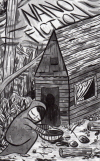NANO Fiction – 2013
As an avid reader of flash fiction, I’ve long admired the diversity of writing featured in NANO Fiction. The journal’s 500-word ceiling for stories results in a showcase of quick, narrative-driven flash as well as prose that lingers with a heavy dose of lyricality. It ranges in genre from what we might call realist flash to work that is much more surreal, and everything in between. Through it all, the journal values work featuring language that is playful, explorative, and sharp.
As an avid reader of flash fiction, I’ve long admired the diversity of writing featured in NANO Fiction. The journal’s 500-word ceiling for stories results in a showcase of quick, narrative-driven flash as well as prose that lingers with a heavy dose of lyricality. It ranges in genre from what we might call realist flash to work that is much more surreal, and everything in between. Through it all, the journal values work featuring language that is playful, explorative, and sharp.
NANO Fiction’s most recent issue features not only a host of different forms and styles of flash, but also work that obscures the borders between flash fiction and prose poetry, the real and the surreal, the concrete and the lyrical.
Among the shorter stories that caught my attention were Russ Woods’s “Hammers” and Matthew Maheny’s “The Desert,” two pieces that are vastly different in style despite sharing the very short paragraph form.
“Hammers” is founded on wit and playfulness, as the unlikely premise of the story is revealed in the opening line: “Sara was in a room full of hammers.” It’s a smart piece that always keeps one step ahead of the reader, framing the possibilities of Sara’s next move, line by line, leaving the reader not with a solution, but with a subtle shift in perspective that indicates neither acceptance nor defeat. The piece moves quickly, with crisp, clipped language throughout, each sentence feeding off and linking into the other.
“The Desert” also begins by defining a premise, with an unnamed narrator announcing, “In 1948 only one baby was born in the state of New Mexico, a boy named Samuel.” The prose snaps quickly, though not to the narrative of Samuel, but to the Santa Fe Times’s attempt to discover why New Mexicans failed to reproduce during the year in question. From there the piece begins to purposefully drift, and the answer takes the piece from quick, snappy sentences to an explanation that stretches out and lingers at the edge of story like the desert itself, leaving us “staring out at absolutely nothing but the color red.”
Casey Hannan’s “Till Now” is a longer piece of flash that utilizes dialogue, a strong first-person voice, and the freezing of a powerful narrative moment. “Till Now” tells the story of two men who meet and share a moment of intimacy at a distillery tour. The intimacy isn’t stated outright, however, and the piece itself is driven by a quiet secrecy that gathers momentum from subtle touches of language, gathering momentum off the page to culminate in a moment of highly charged sexual tension.
In another narrative-driven piece of flash, Jacqueline Kharouf takes a seemingly bizarre situation—finding “the perfect miniature buffalo” in an alley—and turns it into something very real. After the narrator brings the buffalo back into her house, she tells him, “You’d think people would be more interested in you,” a line that stands out and gains power as it becomes clear that the woman’s investment in the creature isn’t just something crafted for whimsical effect. Kharouf made me care for the woman and the buffalo—their vulnerability, the ways they rely on each other—in just a very small space, and that’s what gave such power and raw emotion to the story’s final line, the woman’s assertion, “I needed him, I told myself. He needed me, probably.”
Included in this issue is also a new section titled “State of Flash in the Classroom,” which features three short essays about the educational value of flash fiction at the post-secondary level. The essays cover a host of pedagogical topics, including the use of flash to teach elements of fiction, teaching flash exclusively in a class void of creative writing majors, and using flash in writing/art hybrid courses.
It’s an intriguing addition, and—I would argue—an important one to include in the conversation as flash fiction emerges, as Associate Editor Sophie Rosenblum argues, as “an important teaching technology for the 21st century.”
In all, this issue of NANO Fiction is like the many issues before it: stocked with diverse interpretations of flash fiction, all of them smart, sharp and wildly entertaining. These are stories that push boundaries, stories that challenge classifications and genres, and above all, stories that continue the conversation of what the term “flash fiction” means, and how it means it.
[nanofiction.org]





